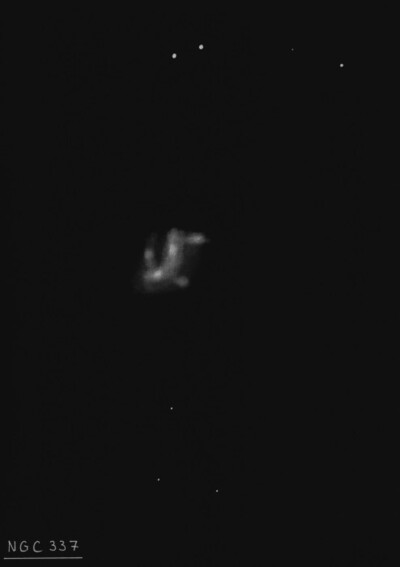
William Herschel discovered NGC 337 = H II-433 = h80 on 10 Sep 1785 (sweep 435) and noted "pB, pL, bM, irregular parallelogram in the direction of the meridian." His position is pretty accurate.
R.J. Mitchell observed this irregular galaxy using LdR's 72" on 3 Oct 1856 and recorded "pL, not vF. Its brightest part is a line running diagonally, and there is a knot at either end. Perhaps it shaped like an "S". The galaxy has a distorted appearance on CCD photo.
300/350mm - 13.1" (9/29/84): fairly bright, moderately large, elongated NW-SE, fairly even surface brightness, diffuse outer halo. A mag 11.5 star is 5.4' E of center.
400/500mm - 17.5" (12/26/00): fairly bright and large, elongated 3:2 NW-SE, ~1.8'x1.2', broad concentration. The appearance is asymmetric -- with a noticeably mottled or irregular surface brightness. Brighter knots within the halo are also clearly visible at moments. The visual impression matches well with the DSS image, which shows a chaotic structure with a number of large HII knots. NGC 337A, a large faint dwarf spiral, lies 27' E.
900/1200mm - 48" (11/1/13): at 488x appeared bright, fairly large, very irregular with a number of obvious clumps. Although the galaxy is generally elongated 3:2 or 5:3 NW-SE it contains a bright, elongated N-S central region that seems to be a bar. On the south end of the "bar" is a brighter elongated patch extending towards the WSW. Another brighter knot is at the north end of the bar, extending to the east. On the southeast flank of the galaxy is an elongated, fainter patch. The northwest side of the halo extends further out, giving an asymmetric outline, and one or two small knots are involved. A mag 11 star lies 5' E.
Notes by Steve Gottlieb